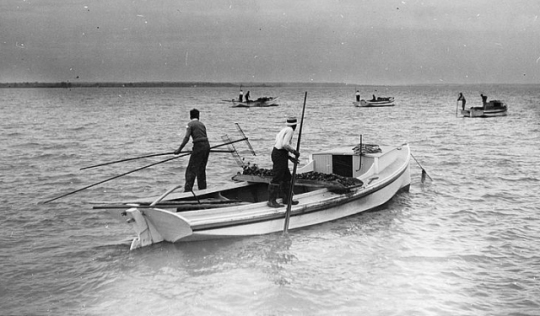 Working an oyster bed. Rock Point, Charles County, Maryland, Sept. 1936. (Photo: Library of Congress)
Working an oyster bed. Rock Point, Charles County, Maryland, Sept. 1936. (Photo: Library of Congress)It is getting embarrassing. As Maryland's General Assembly drew to a close last month, the state's Department of Natural Resources was once again bowing to pressure from watermen whom it is charged by law with regulating. It was the third time in less than a year.
In May of 2015 the DNR fired Tom O'Connell, its respected (including by many watermen) fisheries chief. It was to appease Maryland's most vocal watermen—chief among them Robert T. Brown, president of the Maryland Watermen's Association, whose backing of Governor Larry Hogan's successful election campaign made him influential with Hogan. Also transferred out of the DNR was Mike Naylor, the agency's head shellfish regulator, who presumably made the watermen's hit list because of his concerns about unsustainable fishing of oysters.
Then came the DNR's meeting with oystermen, who urged the agency to stop a multimillion dollar, state-federal program to build oyster sanctuaries in Bay rivers. Rejected by the DNR, the watermen went directly to the Hogan administration, which ordered the DNR to delay work on the sanctuaries. That move has already cost Maryland some $1 million in federal money (given to Virginia for oyster restoration there). But the most recent cave-in by the DNR seemed the worst yet, because the agency opposed carrying out the very science upon which state law requires it to base sustainable management of oysters.
To set the scene:Oysters baywide, depleted by pollution, diseases and overharvest, are at one percent or less of their historic abundance. Their immense capability to filter pollution and provide habitat as they build reefs has made restoring and protecting oysters high priority, along with traditional maintenance of the commercial oystering rooted deeply in the state's culture.
In the last decade or so, Maryland oyster harvests have risen more than 10-fold, to around 400,000 bushels a year, a happy circumstance but one that raises important questions: How much is this bounty a true oyster comeback from disease and pollution? How much is it from a doubling of oystermen who've jumped into fishing by the hundreds since 2010, as prices for oysters rose? And how much is it from a more than 40-fold increase in oystermen pulling dredges behind powerboats, a technique illegal before 2000 for fear its efficiency over traditional tonging and sail dredging might risk overharvesting?
The DNR needs to know. It needs to know how many oysters are out there, at least a very close estimate. It cannot manage, cannot set harvest levels that will prevent overfishing of the public resource unless it can first count what's there to harvest. The DNR knows this works, because Maryland has already done the good science needed to count blue crabs and rockfish. And as a result, it is able to manage both species sustainably for both watermen and sportsmen.
Which brings us to the General Assembly's final days in April, and a hearing on a bill to finally begin the scientific surveys needed to count how many oysters are out there. Oystermen showed up in force to oppose the study. The last few good winters' incomes are proof that all is well, they argued. The state has already taken 25 per cent of the publicly-owned oyster grounds to build sanctuaries. More science would surely lead to more regulations.
A number of environmental, educational and sportfishing groups supported it. Oysters have ecological as well as commercial value. They belong to everyone who loves the Bay, and we don't want more booms followed by busts in their populations as in past decades, they argued.
Then there was the DNR. Twice during the legislative session, the department's secretary, Mark Belton, had assured the bill's sponsor, Sen. Roger Manno (D—Montgomery) that the DNR would remain "neutral" if the bill was amended, which it was. But even neutral appeared once again beyond the DNR's control. To Senator Manno's dismay, it lined up with the watermen and opposed the bill again in the House committee hearing.
The bill passed anyhow, somewhat weakened, but still in a form supporters say will make a long overdue start on putting oysters under science-based management. Governor Hogan took the passive approach in late May, choosing to neither veto nor sign the bill, allowing it to become law.
The DNR now claims support for the studies, which it will carry out with the University of Maryland's Center for Environmental Science (UMCES). That should ensure some independence from oyster politics. Years ago, when the DNR and the U.S. Environmental Protection Agency were denying the need to control nitrogen—now acknowledged as the Bay's principal pollutant—UMCES' science convinced a federal judge to overrule both the state and federal governments.
Let's hope Governor Hogan is able to turn a corner with oysters. The DNR should of course listen to watermens' concerns, and it's fair for oystermen to play political hardball. But DNR can't play ball if Hogan keeps taking the bat out of its hands.
Tom Horton, a former Baltimore Sun reporter, has written about the Chesapeake Bay for more than 40 years, including eight books. He lives in Salisbury, Md., where he is a professor of environmental studies at Salisbury University.


